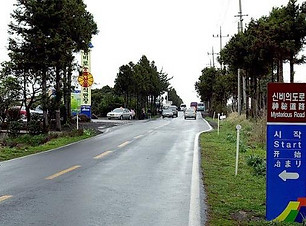
Best Travel in Korea
TEL : +82-2-765-9621

FOREIGN TOUR KOREA
Visit Korea & Seoul City Tour

S-LOCAL TOURS

S4- Tour of Andong Hahoe Village
Hotel departure--Andong-dong, Buyongdae, Hahoe Folk Village Village-Byeongsanseowon Confucian Academy-Bongjeongsa Temple-Hotel
more than 5 people: Ask for a quote
1 P/P : ₩ 229,000 min. 4 people

S2- A two-day tour of Gyeongju
Day 1: Hotel departure-Gyeongju (four hours)-resting-rest area, Seokguram, Bulguksa-Hotel
Day 2: Hotel-National Museum-Anapji-Daeyukwon- Cheomseongdae-go to Seoul -Hotel
included : Breakfast 1 time, business hotel twin,tour guide, vehicle (not included meal)
more than 5 people: Ask for a quote
1 P/P : ₩ 329,000 min. 4 people

S5- Tour of Gyeongju Busan (2 nights and 3 days)
1Day : Seoul Departure-Lunch at the Rest Area-Gyeongju- Sokgulam-Bukguksa-Hotel
Day 2: Hotel-National Museum-Anapji-Daeyukwon- Cheomseongdae-Busan-Hotel
Day 3: Hotel, Yongdusan Park, Taejongdae, Haewoondae, United Army Cemetery, Dalmaji Pass-Seoul
included : Breakfast 2 time, business hotel twin,tour guide, vehicle (not included meal)
more than 5 people: Ask for a quote
1 P/P : ₩ 569,000 min. 4 people
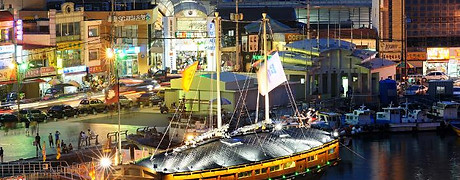
S3-Geoje Busan Tongyeong 2-day tour
Day 1: Hotel-Busan (4 hours)-Yongdu Mountain Park, Haeundae-Jagalchi Market-Hotel
Day 2: Hotels--Taejongdae-- Movie street--Wind hill-- Shinseondae, Mammy-Sung, Tongyoung Nightscape--Hotel
Day 3: Hotel-Tongyoung Marine Cable Car-Hazer Tunnel-go to Seoul -Hotel
included : Breakfast 2 time, business hotel twin,tour guide, vehicle (not included meal)
more than 5 people: Ask for a quote
1 P/P : ₩ 599,000 min. 4 people

S6- Jeju Island Tour (2nights and 3days)
Day 1: Kimpo Airport Meeting-Jeju Transfer-Yongduam-Jeju Natural History Museum-Iho Beach-Hotel
Day 2: Hotel-Cheonjiyeon Falls-Oldolgae-Ju Sangjeol-joongmun-Seongsan Ilchulbong Tuff Cone--Seopjikoji Beach-Hotel
Day 3: Hotel-Halla Arboretum-World Cup Stadium-Dohaebi Road-Seoul
included : Breakfast 2 time, business hotel , jeju air twin,tour guide, vehicle (not included meal)
more than 5 people: Ask for a quote
1 P/P : ₩ 720,000 min. 4 people
Reservation
INFORMATION
Reservations for local tours :
Reservations must be made no later than 5 days before the tour.
You have to check if it's possible, and when you make a reservation, It's basically 20%.
Include :
Language expert guide, vehicle, article, pick-up & sanding, admission fee
Pick-up and Sanding :
Pick-up sandals are served at the hotel where guests stay in Seoul.
Pick-up and sanding time may be delayed due to traffic and protest etc.
Payment item :
You can pay by credit card, cash, and foreign currency.
All products are based on supply price and add 10% additional tax. Cancel Tour :
There will be a 100% cancellation fee for the cancellation of the tour on the day of the tour.
It is considered a cancellation of the tour on the day after 16 p.m. prior to the tour.

Royal Tomb of King Muryeong
The Royal Tomb of King Muryeong is located at the 5-1 mountain in Geumseong-dong, Gongju, South Chungcheong Province, and is included in the Songsan Gorgebun County, designated as Historic Site No. 13, 1963. The Songsan Gobun Tomb consists of the stone chamber tomb of Baekje, which was built in the style of tombs of the ruling classes of the Chinese Yang Dynasty, along with the Royal Tomb of King Muryeong.
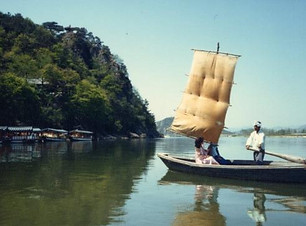
Nakhwaam Rock
On May 17, 1984, it was designated as Chungcheongnam-do Cultural Properties No. 110. According to Baekje Meat of the Three Kingdoms Yusa, when Baekje fell in 660 A.D. (the 20th year of the Baekje Dynasty) due to the invasion of the Union Army of Nadang, the concubines jumped on the rocks of the Baekma River knowing that they would not escape their anger. The rock was called Nakhwa Rock by people.
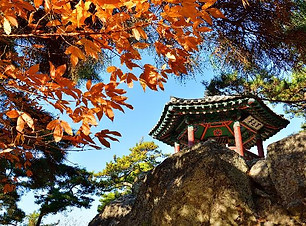
Baekwajeong
On May 17, 1984, it was designated as Chungcheongnam-do Cultural Properties No. 108. It is owned and managed by Buyeo County. It is a hexagonal pavilion built on a rugged rock along the Geumgang River north of BuSosan Fortress in Buyeo. Legend has it that more than 3,000 court ladies fell from the cliff Nakhwa Rock and died when Baekje fell into the territory in 660 (the 20th year of the Baekje Kingdom) due to the invasion of the Union Army.
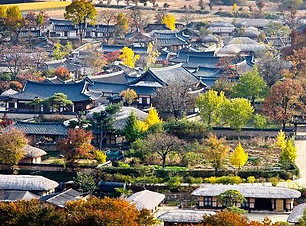
Andong Hahoe Village
It is a clan village of Pungsan Yu, which is well preserved in folk tradition and architecture.The terrain of Hahoe Village is also called Taegeuk-hyung or Yeonhwabu-su-hyung, which refers to a country where the Nakdonggang River stem has formed a "S" shape as it wraps around the village. Across the river, there is Namsan Mountain, a tributary of Mt. Ilwol in Yeongyang County, and behind the village, a volcano, a tributary of Mount Taebaek, gently extends to the center of the village and stops in the backyard of Chunghyodang. To the north of the river, Buyongdae sits around like a folding screen, and the landscape of Sanchon also forms the Taegeuk-style soft-water basin.

Byeongsanseowon Confucian Academy
Byeongsan Seowon, located in Byeongsan-ri, Pungcheon-myeon, is a seowon that houses Seoae Ryu Seong-ryong and his son Ryujin. Mo-tae was located in Pungsan County, Andong, from the time of Goryeo, and when King Gongmin came to the town to avoid the Red Geon-jeok's orchids, he received eight hundred dollars of land that served as a virtual consideration for the visiting children. In 1572 during the Joseon Dynasty, Ryu Seong-ryong moved to his current location. It was burnt by fire during the Japanese Invasion of Korea during the Japanese Invasion of Korea, but in the second year (1610) of Gwanghaegun, it became a seowon as it built a shrine to commemorate Seo Ae's achievements and school virtues at Sarim, which was centered on King Ubok Jeonggyeong, a disciple of Ryu Seong-ryong.
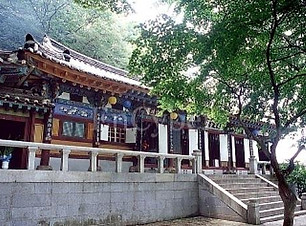
Goransa Temple
It is assumed to have been established at the end of the Baekje Kingdom, but no detailed records are given. There is Goranjeong between the rocks behind the temple and Gorancho between the rocks above it. According to one theory, the temple was originally a pavilion for the kings of Baekje and was also an inner temple of the palace.It is also known as a temple built in 1028 (the 19th year of King Hyeonjong's reign) to console the soul of the Three Heavenly Palace girl who disappeared from Nakhwa Rock during the collapse of Baekje.

Busosanseong Fortress
The fortress is believed to have been built around the 538 (the 16th year of King Seong's reign) capital, Cheonan, in order to protect the capital of Baekje. Before this, however, it is estimated that around 500 years (the 22nd year of King Dongsung's reign), a terraced fortress was built on a mountain peak, but was rebuilt around the time of the day, and expanded to the current scale around 605 (the 6th year of King Mu's reign).

Buyongdae
태백The peak of the Taebaek Mountains provides a view of the entire village from the summit. The name Buyongdae is derived from Chinese ancient history and means lotus flowers. At first, it was called Bukae, which means "heel in the north" of the lower house. The Okyeonjeongsa Temple, Gomamjeongsa Temple and Hwacheon Seowon are located where the Nakdong River winds down.
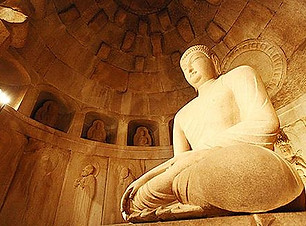
Seokguram
The peak of the Taebaek Mountains provides a view of the entire village from the summit. The name Buyongdae is derived from Chinese ancient history and means lotus flowers. At first, it was called Bukae, which means "heel in the north" of the lower house. The Okyeonjeongsa Temple, Gomamjeongsa Temple and Hwacheon Seowon are located where the Nakdong River winds down.
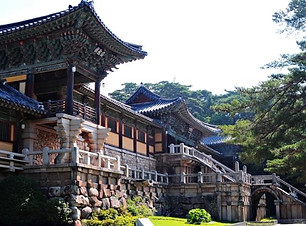
Bulguksa Temple
There are two theories about the establishment of Bulguksa. One of them is the Bulguk Sasanggi, which was founded in 528 (the 15th year of King Beopheung's reign) by the origin of his mother, Yeongje wife, who was the mother of King Beopheung, in 574 and became the mother of King Jinheung's father, Mrs. Jiso, by building a Buddhist temple and holding a Buddhist temple.
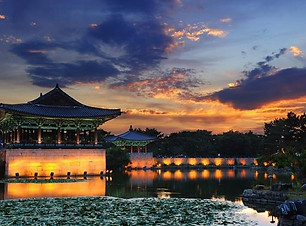
Anapji Pond
In 674 (the 14th year of King Munmu's reign), it was said that he dug a nail into the palace and built a mountain to raise a garden plant and raised Jingeumsu, but it is believed that Anapji was attached to Imhaejeon without being sold at that time. Since 1974, remarkable relics and relics have been discovered by dredging and archaeological research. It is a 200-meter-long and 180-meter-long sphere in the east and west of the country. Three large and small islands were deployed

Observatory
On December 20, 1962, it was designated as National Treasure No. 31. It is located in Inwang-dong, Gyeongju, North Gyeongsang Province, and is 9.17 meters high, 4.93 meters in diameter and 2.85 meters in diameter. It has a square door with one side on its southern waist, which is 4.16 meters from the bottom. The shape is cylindrical, and there is a place where the ladder was hung on the south door. Using 361 stones, which are 30 centimeters tall, he piled up 27 layers, excluding the upper part and the podium.(The total number of stones is 401)
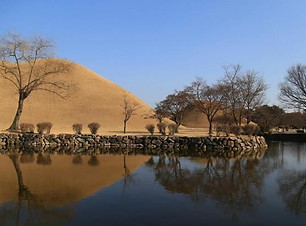
Daerungwon
It is called the Daerungwon District. The name Daerungwon is derived from the records of the Three Kingdoms Sagi (Samnung Sagi) that "King Michu was buried in Daerung."The total area is 125,400 pyeong and houses 23 tombs of Silla-era kings, queens, and noblemen. The tombs are unique tombs of the Silla Dynasty, all located on a flat land, and are divided into seven areas.
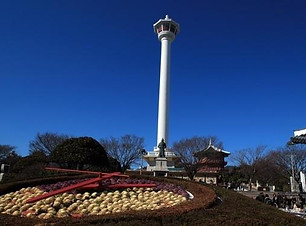
Yongdusan Park
Yongdusan, 49, is a hill in downtown Busan and one of the three mountains in Busan. In the old days, the sea was seen through thick pine trees, so it was called Songhyeon Mountain, and since the mountain was almost like a dragon, it was called Yongdusan Mountain because it was a weather that would swallow up the wagons that came from Japan.
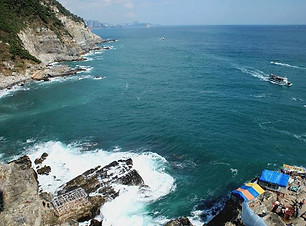
Taejongdae Park
Taejong Muyeol of Silla, who unified the Three Kingdoms, was named Taejongdae because he took a break while touring the country. It is also said that King Taejong of Joseon also took a tour here, and Dongnaebusa was a place where he used to hold a memorial service during his stayAlong the southern tip of Yeongdo, the highest peak is 250 meters high, and the whole mountain is surrounded by decades-old dense forests, and protrusions facing the sea are made of a rock cliff.

haeundae beach
It is one of the most famous eight scenic spots in Korea, and has received praise from many people since ancient times, with another eight scenic views of Haeundae itself. Even if the name "Haeundae" was named, scholars of the late Silla Dynasty, Choi Chi-won, decided to drop his fortune after being pessimistic about Nansse and entered Haeinsa on his way to Seoul, where he was buried under a rock on Dongbaek Island, and the three letters still stand on the rock.
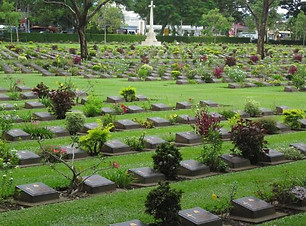
U,N Memorial Park
The U.N. Memorial Park is the world's only U.N. cemetery, where U.N. war dead who have given their lives for the cause of world peace and freedom lie dormant. The cemetery was established by the United Nations Command for the war dead's stores in January 1951, the year after the Korean War broke out, and the remains of U.N. war dead who had been buried in Kaesong, Incheon, Daejeon, Daegu, Miryang and Masan began to be buried when the graves were completed in April of the same year.
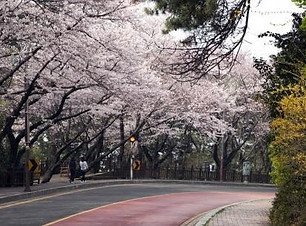
Dalmajigogae
It is also called Dalmajigogae. It is a pass along the middle of Wuxan Mountain that runs from Haeundae Beach to Songjeong Beach. It is also called 15 Gokdo because it has 15 hoofs. The 8-kilometer stretch of coastal road lined with cherry trees and pine trees is a famous drive course. Mount Dalmaji on the top of the pass is called Haewoljeong. In addition, Cheongsapo and Dalmae-gil Oulmadang are located along the coast, while cafe towns, flower shops, and restaurants are on the other side.
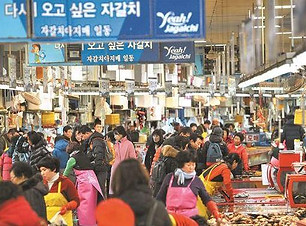
Jagalchi Marke
Busan Jagalchi Market is a traditional market that represents Busan along with international markets and Bupyeongkangtong Market. It is one of the most popular tourist attractions in Busan, symbolized by Jagalchi Azimae, and offers a variety of seafood including sashimi.Today, the place where Jagalchi Market is located was called Nambin, which means "water in the south." There are a fist-sized gravel on the beach named Jagalchi Market is the Japanese occupation, and sailing south through the landfill and reclamation work was built.

wind drift
Geoje Island is filled with the beauty of nature, but let's not miss the hills of the wind that are more beautiful than the name. The hill, which is called the title of the movie, has become famous for its true setting in many dramas. The hill lying low as a natural breakwater on the right side of the small port of Dojangpo, where the Haegeumgang cruise ship dock is located, is picturesquely covered with blue grass. As you climb the hill along the walkway connected with the wooden steps, the wind blows as if it were hard to keep you under control.

Sinsundae
It is a huge rock on the beach of Dojangpo Village in Galgot-ri, Nambu-myeon, Geoje-si, Gyeongsangnam-do. The place where Shinseon used to play is called Sinsundae, and is called Sinseongdae. It is also called "gatbawi," and there is a myth that a person who wants a government post can fulfill his or her wish if he or she raises the rite on the rock. Standing on the rock, there is a view of the sea far away, and beside the rock is Hammok Beach, a small beach covered with mongoing stones. There is an observatory on the hill of Dojangpo Village, which is good for enjoying the Tak-in sea scenery.
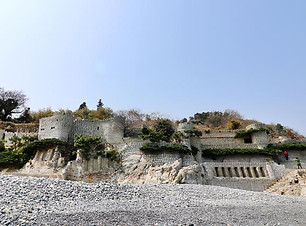
Maemi Castle
Maemi Castle is a wall that Baek Soon-sam, a citizen who lost his arable land to Typhoon Maemi in 2003, has built up alone for a long time to protect crops from natural disasters. Stack of square stones near the beach and fill them with cement, which is now reminiscent of the Middle Ages in Europe. Its size and design are unbelievable to have been built without a single design.
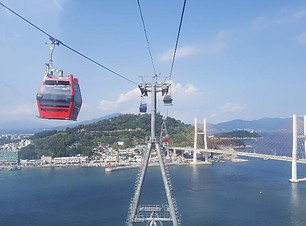
marine cable car
The Hanryo Island View Cable Car, installed on Mount Mireuk, one of the nation's 100 most famous mountains, is the longest tourist cable car in Korea (1,975 meters). At an average speed of 4 meters per second, it will take about nine minutes to reach the upper station and 48 gondolas will circulate. If you climb to the top of Mt. Mireuk, you will be able to see the historic site of Hansan Daecheop, the 300-ri Halla Maritime National Park from Hansando Island to Yeosu, Japan's marijuana, Mount Jiri's Cheonwangbong and the Dolsan Island of Yeosu.
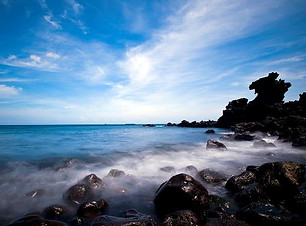
Yongduam Rock
The rock, which is shaped like a dragon head on the beach near Yongyeon, is about 10 meters high and is a popular tourist destination in Jeju. It is said that volcanic lava cooled down to the sea and was formed by sea food, and that the dragon failed to achieve its goal while trying to climb it.
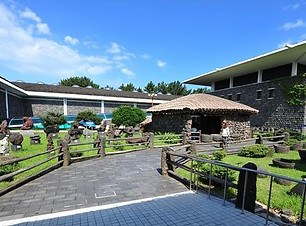
natural history museum
The nature of Jeju has local characteristics, and the spirit of Jeju Island, which is proud of the spirit of Sammu and Jorang, which are the unique beautiful customs of this town, has been developed by the people of this town, who fought the rough sea. Unlike inland areas, Jeju Island has different and different processes for its creation, so the distribution of animals and plants has different characteristics than inland areas.
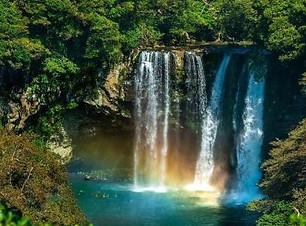
Cheonjiyeon Falls
Cheonjiyeon Falls, a white water pillar that thunderously flows down the cliff. It is also called Cheonjiyeon because the sky and the earth meet. The 22m-high, 12m-wide waterfall is spectacularly falling down the cliff. In the valley of Cheonjiyeon Falls, the natural monument No. 163 bilfalwood trees are self-developed, and the orchids of rare plants such as pine trees, citrus chestnut trees, wildlings, and camellia trees form a dense forest.
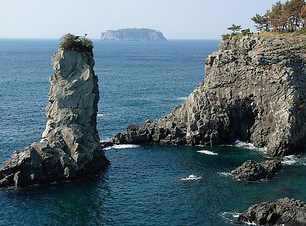
Oedolgae Rock
After passing by, the longing became a stone and the most notable of the stone cliffs surrounding the seashore of Seogwipo Chilsimni on the Haemgeum River in Namju, Oedogae, was the 20-meter-high pillar rock.
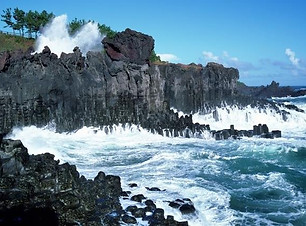
columnar joint
The east coast of the Jungmun Tourist Complex, which is spread like a folding wave and finely overlaid black, red, hexagonal stone pillars, is designated as Natural Monument No.443 (2004. 12. 27) as a natural monument to the greatness and subtlety of nature.
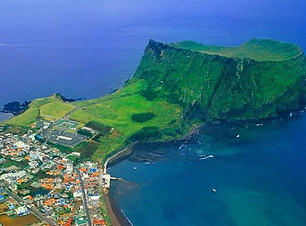
Seongsan Ilchulbong Tuff Cone
The Seongsan Ilchulbong Peak, which is 182 meters above sea level, is a volcanic object that exploded underwater in the sea, rare among numerous craters on Jeju Island 100,000 years ago. Although it was originally a volcanic island, sand and pebbles were piled up between the land on the side of the Sinyang Beach and the island, connecting it to the land. At the top of Ilchulbong Peak, there will be a crater with a diameter of 600 meters and a height of 90 meters above sea level with an area of 80,000 pyeong.
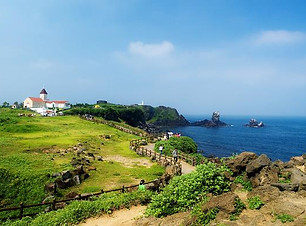
Seopjikoji Beach
Seomji Koji, which bulges out on the east coast of Jeju Special Self-Governing Province, has a beautiful view of the coast with yellow rape flowers and Seongsan Ilchulbong in spring. The Shinyang Beach beach on the head of the field, the rape fields on the hilltop, the leisurely grazing Jeju ponies, and the coastal cliffs surrounding the rocks and the towering legendary rock rock are typical of Jeju's beauty.
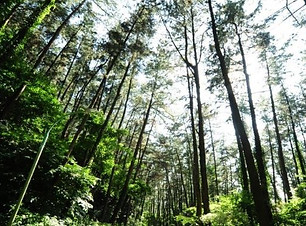
Halla Arboretum
Located at the foot of Gwangi Oreum near Jeju-si Interchange, Halla Arboretum is an arboretum where more than 1,100 kinds of plants, including self-breeding and subtropical plants, are on display, serving as a venue for education and research for students and professionals, as well as receiving great love from ordinary tourists as a theme tourist.
